Week 4 – April 28, 2011 – AMA Presidents According to the 1948 By-laws of the AMA, Article IX, Section 2:
According to the 1948 By-laws of the AMA, Article IX, Section 2:
“The President shall be the Chief Officer of the A.M.A., shall preside at all meetings of the A.M.A., and shall, ex-officio, be a member of all regular and special committees.”
The wording has varied slightly over the years, and provisions about not serving on the nominating committee and the ability to create or dissolve committees has been added. Essentially, though, the description of the President’s job hasn’t changed too much since 1948. Such a bland statement seems to barely summarize the work that is involved with being President, or being any elected representative of the AMA for that matter.
When taking office in 1963, John Worth noted in his first quarterly report, “In the past it often has taken six weeks to six months for newly elected and appointed officers to get rolling and effectively operating. It is no exaggeration to say that only about six days were allowed this year!” (Worth, John. “President’s Progress Report, First Quarter,” Model Aviation, vol. 22, no. 4, April 1963, pg. 4.)
Here’s a list of the hard-working people who have stepped up to the challenge of being president:
1936-1937 1st President
Willis C. Brown
Elected to serve in 1936 by Council
Elected to serve in 1937 by membership ballot
1938 2nd President
Albert L. Lewis
Elected by membership to serve through calendar year
1939-1942 3rd President
Edward Roberts
1943-1946 4th President
Irwin G. Ohlsson
1947-1948 5th President
Everett N. Angus
1949-1950 6th President
C.O. Wright
1951 7th President
Kenneth Held
1952 8th President
Frank B. Bushey
1953-1956 9th President
Keith H. Storey
1957-1958 10th President
Claude McCullough
1959-1960 11th President
Dr. Walter A. Good, PhD
1961-1962 12th President
Peter J. Sotich
1963-January 1964 13th President
John Worth
February 1964-December 1964 14th President
Maynard Hill
1965-1966 15th President
Howard E. Johnson
Note: Two-year terms were initiated in 1965. The rule lasted through 1970.
1967-1968 16th President
Cliff Weirick
1969-1970 17th President
John E. Patton
1971-1978 18th President
John Clemens
1979-1980 19th President
Earl Witt
1981-1986 20th President
John Grigg
1987-1995 21st President
Don Lowe
1996-2007 22nd President
Dave Brown
2008-2011 23rd President
Dave Mathewson
1. John Worth relates AMA business in his first progress report as president in 1963. (Source: National Model Aviation Museum Library [Worth, John. “President’s Progress Report, First Quarter,” Model Aviation, vol. 22, no. 4, April 1963, pg. 4.])
Week 3 – April 21, 2011 – Life Memberships start. An in-depth and serious examination of the AMA’s operations and budget took place in 1963, led by then-new president John Worth. The result of the financial investigation was startling. The AMA, which had never had a set budget or any detailed financial tracking prior to 1963, was losing money and in debt. In November of 1963, John Worth announced a dues increase and operational changes to improve efficiency, but the AMA was still in trouble. To help the AMA, P.J. (Jack) Baugh, an active modeler, full-scale pilot, and entrepreneur, quickly responded with a donation of $1,000.
To honor Baugh’s contribution, the AMA created the Life Member category, and awarded him the first Life Membership. He was issued AMA #L-1. Today, Life Memberships can be either purchased or won as an award. Currently, there have been 1,462 Life Memberships given, with 1,277 of those members of still living.
Links:
Biography of Jack Baugh: https://www.modelaircraft.org/files/BaughJack.pdf
Life Membership information: https://www.modelaircraft.org/files/913.pdf
2. 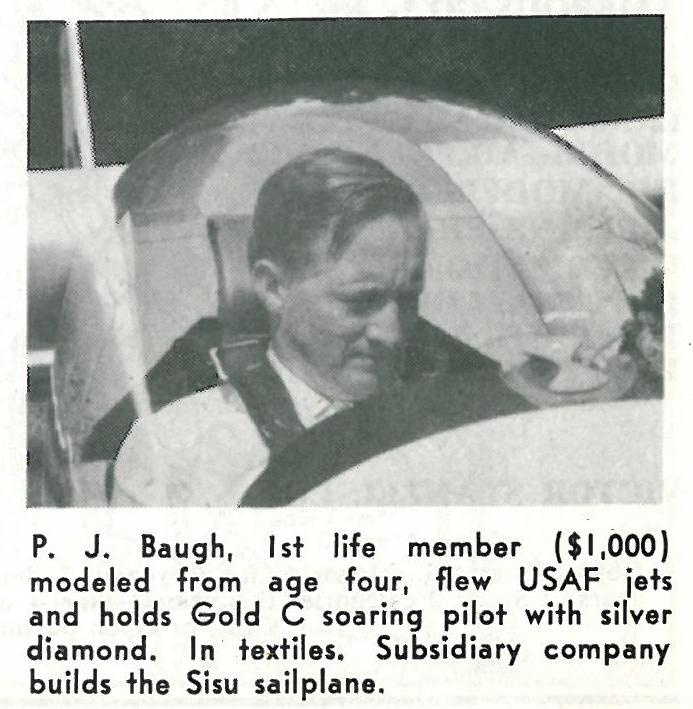 3.
3.
1. The November 1963 issue of Model Aviation included an article explained the AMA financial situation that was causing a dues increase. (Source: National Model Aviation Museum Library [Worth, John. “Why a Dues Increase?” Model Aviation, vol. 23, no 5, November 1963, pgs. 4-5.])
2. News of P.J. Baugh’s contribution first appeared in Model Aviation, May 1964. (Source: National Model Aviation Museum Library [AMA Staff. “1st Life Member,” Model Aviation, vol. 24 no. 5, May 1964, pg. 1.])
3. AMA Life Members receive gold-colored metal cards engraved with their name and license number. The card design shown was used from the mid-1980s to the mid-1990s. (Source: National Model Aviation Museum Collection, AMA Collection, 2008.05.128.)
Week 2 – April 14, 2011 – Ideal Aeroplane & Supply Co.
The Ideal Aeroplane & Supply Co., Inc. was one of the earliest model airplane companies in the United States. Founded in 1911, they specialized in creating kits that included everything needed to build a “scale-reduction” model airplane, from the covering and glue, to the wood, hardware and tools. They sold these kits through their catalog, along with individual parts, supplies, and equipment for those who wanted to build from scratch.
To advertise their models, in the late 1920s they awarded a certificate suitable for framing and a lapel pin to those pilots who proved their Ideal Model Airplane flew well. In the words of the 1928 Ideal Catalogue, “this feature provides an added incentive to build and fly Ideal Model Airplanes and thus demonstrate craftsmanship and ability in their construction and flight.”
1. 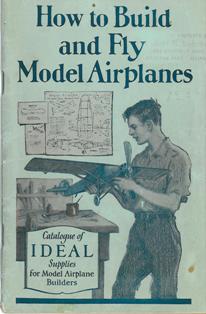 2.
2. 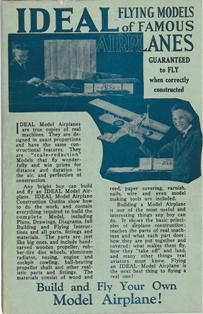
1. & 2. The front and back cover of How to Build and Fly Model Airplanes: Catalogue of Ideal Supplies for Model Airplane Builders, 1928. The back cover proclaims, “Flying an IDEAL Model Airplane is the next best thing to flying a real one!”
(Source: National Model Aviation Museum Archives, Manufacturers and Companies Collection #0043 [How to Build and Fly Model Airplanes, Ideal Aeroplane & Supply Co., Inc., 1928.])
3. This advertisement in the 1928 Ideal Catalogue encourages model builders and pilots to submit proof that their models, built from an Ideal kit, flew to certain standards. (Source: National Model Aviation Museum Archives, Manufacturers and Companies Collection #0043 [“Awards Given for Successful Flight,” How to Build and Fly Model Airplanes, Ideal Aeroplane & Supply Co., Inc., 1928, pg. 25.])
4. This lapel pin was awarded, along with a certificate, to builders who secured a creditable flight from a model built from an Ideal Model Airplane kit. This is the same pin that is advertised in the 1928 Ideal Catalogue. (Source: National Model Aviation Museum, George B. Armstead, Jr. Collection, 2006.49.69.)
5. & 6. The order form and envelope for Ideal Model Airplane supplies, 1928. (Source: National Model Aviation Museum Archives, Manufacturers and Companies Collection #0043 [How to Build and Fly Model Airplanes, Ideal Aeroplane & Supply Co., Inc., 1928.])
7. An Ideal Model Kit for a Curtiss Military Tractor in its original box. While the kit still contains the plans, rubber motors, and a small aluminum bottle of Ambroid Cement, there are no wood pieces, or other components. (Source: National Model Aviation Museum, donated by Dr. Vern McIntosh, 2007.43.04.)
8. This scale Wright Flyer was built by museum volunteers from plans published by the Ideal Aeroplane & Supply Co. Inc. in 1911. (Source: National Model Aviation Museum, Made for Museum, 2011.04.01.)
Week 1 – April 7, 2011 – Model Aviation Magazine, a Brief History
The Academy of Model Aeronautics (AMA), as an organization, has always been very interested in informing its members of current aeromodeling activities. In fact, this is so much so that the first issue of Model Aviation (MA) was printed and distributed before the organization even officially existed. Issue 1, Volume 1 was provided to those attending the 1936 National Aeromodeling Championships prior to the first official meeting held at the end of those Nats. For the next two decades, MA was provided to AMA Leader Members and subscribers, and in 1954, all AMA members began to receive MA as part of their membership benefits.
In 1966, in search of ways to reduce costs and increase members, combined with a unique opportunity offered by new owners of the magazine American Aircraft Modeler (AAM), the AMA council agreed to provide all members with a subscription to AAM rather than continue with its own separate publication. As part of this agreement, AMA news and events were included in a special section of the magazine. For the AMA it was hoped that by publishing in a separate magazine, AMA members would still receive their AMA news, but also read exciting modeling feature articles. They also hoped that more modelers could be exposed to AMA news and events, and might therefore become members. For AAM, due to the nature of its new ownership, the reduction in paying subscribers verses the rising numbers of AMA members paying only a fraction of the subscription rate, was not a concern. Due to the bimonthly nature of AAM during 1966, special MA issues would be mailed to chartered clubs and contest directors until AAM began monthly publication in 1967. From 1966 to 1975 membership increased from 16,000 to 52,000.
This arrangement worked well for nine years, until AAM announced in February 1975 that it was filing for bankruptcy. Suddenly the AMA was going to be without a way to communicate to its members. “AMA officers saw most members preferring to receive a magazine with well-rounded features at reasonable cost instead of a small newsletter- and authorized the revival of MA with 80 pages.” (Model Aviation, July 1975, pg 3)
With only two months to prepare, advertisers were located and contributing editors and columnists were approached. The result of this hard work was the first issue of the new Model Aviation magazine published in July of 1975. Today, after 36 years, MA is the flagship of the AMA publication efforts, continuing to provide members with aeromodeling news, event coverage, new product announcements, and district reports.
1. The first published issue of Model Aviation. (Source: National Model Aviation Museum Library [Model Aviation, vol. 1, no. 1, May 1936, cover.])
2. This was the last issue published before the move to American Aircraft Modeler. (Source: National Model Aviation Museum Library [Model Aviation, June 1966, cover.])
3. The first issue of American Modeler (which later became Amerian Aircraft Modeler) to include a dedicated section to AMA news. (Source: National Model Aviation Museum Library [American Modeler, July/August 1966, cover.])
4. The first issue of the revived Model Aviation in July 1975. (Source: National Model Aviation Museum Library [Model Aviation, July 1975, cover.])
![Pic 1 - John Worth relates AMA business in his first progress report as president in 1963. (Source: National Model Aviation Museum Library [Worth, John. “President’s Progress Report, First Quarter,” Model Aviation, vol. 22, no. 4, April 1963, pg. 4.])](https://www.modelaircraft.org/sites/default/files/images/Week%204,%20April,%20Pic%201.jpg)
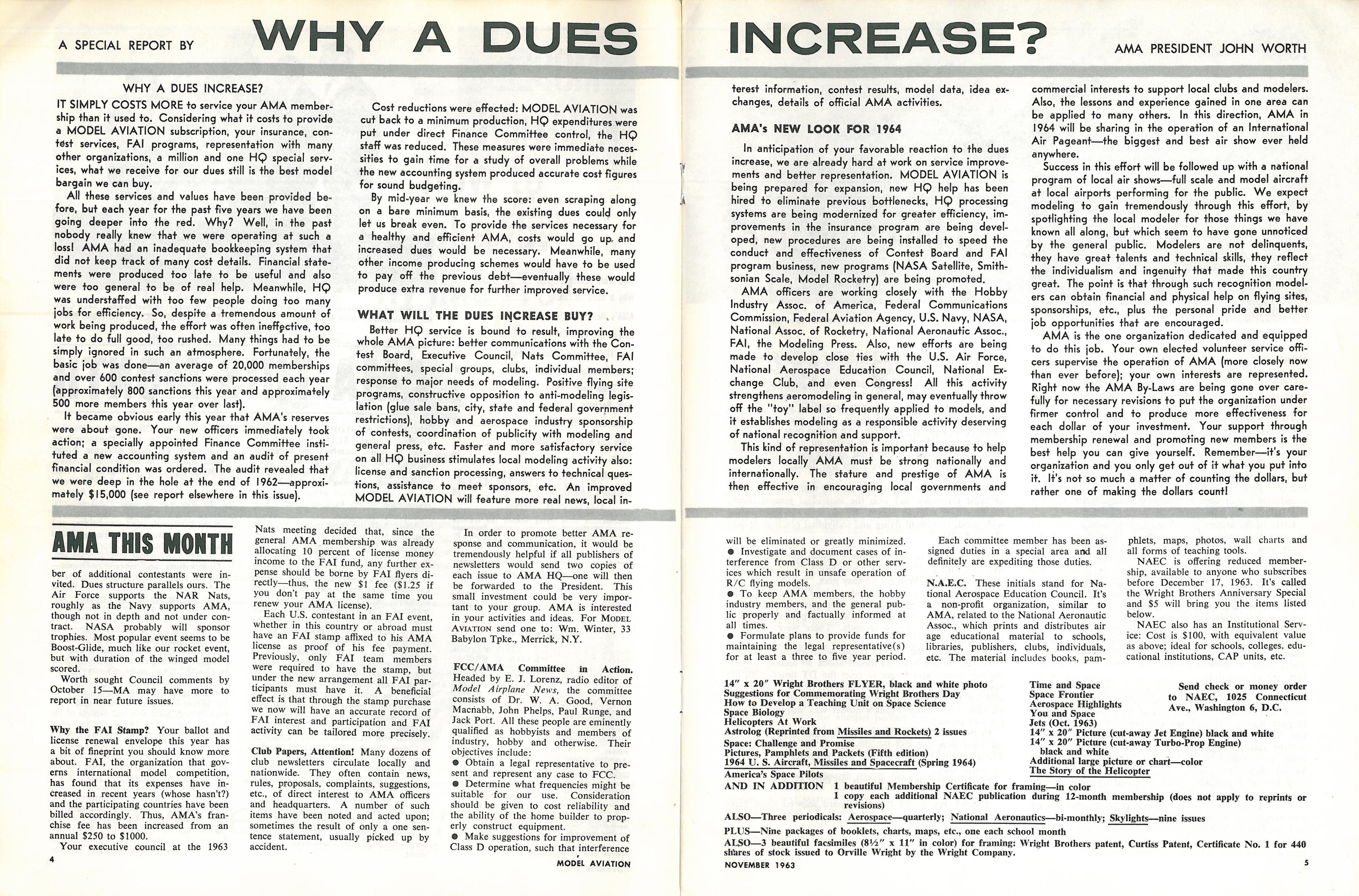
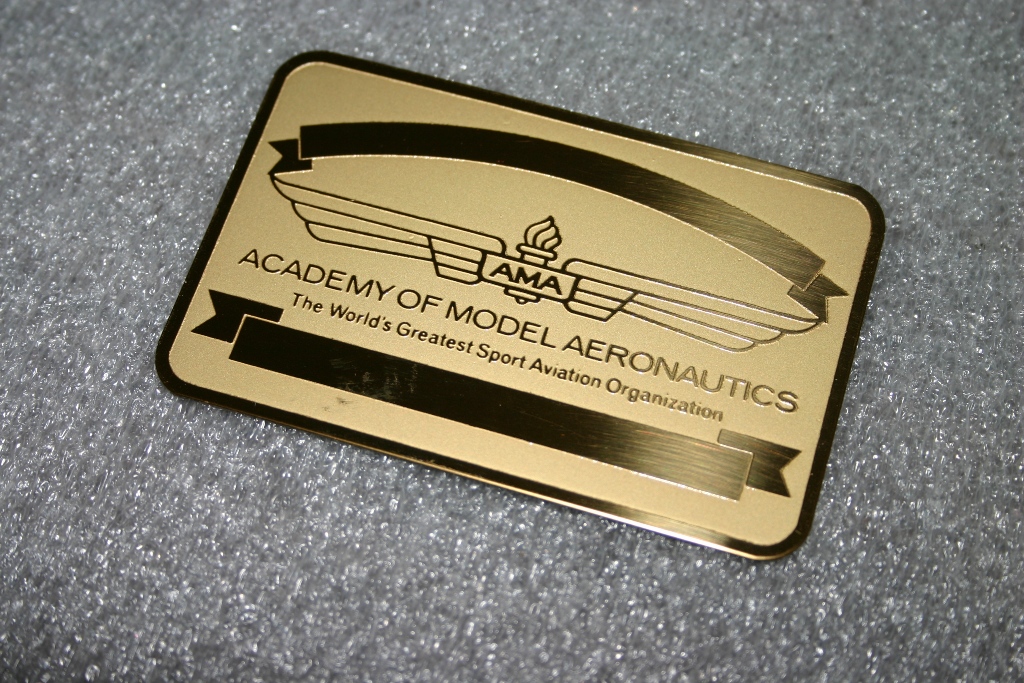
![This advertisement in the 1928 Ideal Catalogue encourages model builders and pilots to submit proof that their models, built from an Ideal kit, flew to certain standards. (Source: National Model Aviation Museum Archives, Manufacturers and Companies Collection #0043 [“Awards Given for Successful Flight,” How to Build and Fly Model Airplanes, Ideal Aeroplane & Supply Co., Inc., 1928, pg. 25.])](https://www.modelaircraft.org/sites/default/files/images/idealawardsad_sm.jpg)
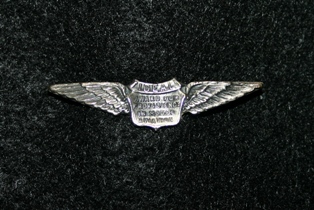
![The order form and envelope for Ideal Model Airplane supplies, 1928. (Source: National Model Aviation Museum Archives, Manufacturers and Companies Collection #0043 [How to Build and Fly Model Airplanes, Ideal Aeroplane & Supply Co., Inc., 1928.])](https://www.modelaircraft.org/sites/default/files/images/idealorderform_sm.jpg)
![The order form and envelope for Ideal Model Airplane supplies, 1928. (Source: National Model Aviation Museum Archives, Manufacturers and Companies Collection #0043 [How to Build and Fly Model Airplanes, Ideal Aeroplane & Supply Co., Inc., 1928.])](https://www.modelaircraft.org/sites/default/files/images/idealenvelope_sm.jpg)

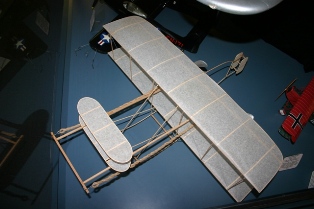
![The first published issue of Model Aviation. (Source: National Model Aviation Museum Library [Model Aviation, vol. 1, no. 1, May 1936, cover.])](https://www.modelaircraft.org/sites/default/files/images/mav1cover1936_sm.jpg)
![This was the last issue published before the move to American Aircraft Modeler. (Source: National Model Aviation Museum Library [Model Aviation, June 1966, cover.])](https://www.modelaircraft.org/sites/default/files/images/ma061966_sm.jpg)
![The first issue of American Modeler (which later became Amerian Aircraft Modeler) to include a dedicated section to AMA news. (Source: National Model Aviation Museum Library [American Modeler, July/August 1966, cover.])](https://www.modelaircraft.org/sites/default/files/images/aam070866_sm.jpg)
![The first issue of the revived Model Aviation in July 1975. (Source: National Model Aviation Museum Library [Model Aviation, July 1975, cover.])](https://www.modelaircraft.org/sites/default/files/images/ma0775_sm.jpg)
It is very disappointing that the pictures/graphics for this page do not show on the web page. If you click on the space for the pictures, it gives a 404 page not found errors, and says the picture is not on the server.
Thank you for letting us know… The images should be fixed now.
It appears that it has been a while since you’ve done a Fly-By episode but if you ever do them again, may I suggest that you look at Ed Kazmirski’s Taurus. It had an interesting and groundbreaking history on its own, and later, the story of it’s rescue from a crawlspace and ultimate restoration and donation to the museum is also noteworthy.
Just a thought
thank you for sharing the idea!